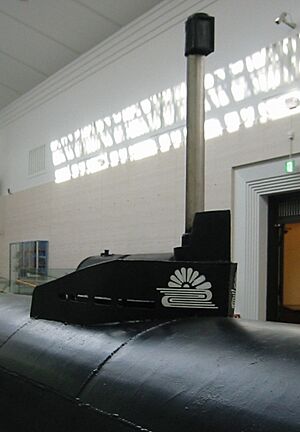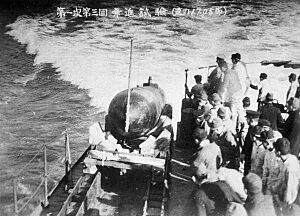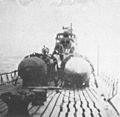Kaiten facts for kids
The Kaiten (pronounced Kai-ten) was a special type of torpedo used by the Japanese Navy during the final months of World War II. Its name in Japanese means "Change the World" or "Reverse Destiny". Unlike regular torpedoes, the Kaiten was guided by a pilot who steered it directly into enemy ships. It could be launched from submarines or larger ships.
Contents
How the Kaiten Was Developed
The very first Kaiten was made by changing a regular Type 93 torpedo. Engineers added a small room for a pilot instead of the torpedo's explosive front part. They also put in controls so the pilot could steer the weapon.
The main people who designed and tested the Kaiten were Lieutenant Hiroshi Kuroki and Lieutenant Sekio Nishina. Both of them died while testing or using the Kaiten. Lieutenant Kuroki died during an early training test.
In total, six different models of Kaiten were designed. Most of these, like Types 1, 2, 4, 5, and 6, were based on the Type 93 torpedo. Only one model, Type 10, was based on the Type 92 torpedo. However, only the Type 1 Kaiten was ever used in real battles. The others were just prototypes.
Early designs of the Kaiten allowed the pilot to escape after guiding the weapon close to its target. But there are no records of any pilot ever trying to escape. Because of this, later Kaiten models were built so the pilot could not get out once inside. Each Kaiten also had a special control for the pilot to blow it up if the attack failed.
How the Kaiten Was Used
Kaiten were meant to be launched from submarines, surface ships, or even from bases on the coast. For example, the cruiser Kitakami was set up to carry eight Kaiten for trials. Some destroyers were also changed to carry Kaiten.
In actual battles, only the Type 1 Kaiten was used, and it was always launched from submarines. Twenty-one special submarines were equipped to carry Kaiten, usually two, four, five, or six depending on the submarine's size. The Kaiten were attached to the submarine's deck. A small tube allowed the pilot to enter the Kaiten from inside the submarine, even when underwater.
Kaiten could not dive very deep. This meant the submarine carrying them also had to stay at a shallow depth. This was one reason why many submarines carrying Kaiten were sunk. Eight submarines were lost, but they only managed to sink two enemy ships and damage a few others.
When a target was found, the pilot would get ready. The Kaiten's engine would be prepared, and the pilot would enter the small cockpit. The pilot would then get final instructions and information about the target.
Once ready, the Kaiten would separate from the submarine and speed towards the target. When close enough, the pilot would briefly surface to check the target's position using a periscope. After making any needed adjustments, the pilot would dive again, arm the explosive warhead, and steer the Kaiten directly into the enemy ship. If the pilot missed, they could try to turn around and attack again. If the mission completely failed, the pilot could choose to blow up the Kaiten.
Related pages
Images for kids
See also
 In Spanish: Kaiten para niños
In Spanish: Kaiten para niños


























